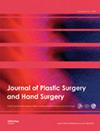尺神经深支的地形在两性之间:具有潜在临床意义的尸体研究。
IF 1
4区 医学
Q3 ORTHOPEDICS
引用次数: 0
摘要
缺乏对尺神经深支(DUN)的地形解剖的细致了解可能会造成困难,导致DUN损伤的延误或误诊。如果没有精确的解剖标志作为参考点,识别DUN是相当困难的。目前的研究调查了不同性别间DUN的地形,以卡普兰线作为参考点,卡普兰线在手部手术中用于腕管释放。我们用放大镜(3.5倍和5.0倍)解剖了22只(15男7女)新鲜冷冻成人尸体的手。我们将卡普兰线近端标记为阳性(+),将远端标记为阴性(-)。dunp - kaplan线平均距离为1.69±4.45 mm。男性手距Kaplan线远端平均距离为4.17±1.88 mm,女性手距Kaplan线近端平均距离为-4.92±0.69 mm。性别二态性被检测到,男性的手具有更高的统计学意义(p = 0.001)。对DUN地形、病程和分布模式的尸体研究并不常见。目前的研究以卡普兰线为参考点,对DUN地形进行了准确的描述,强调了性别差异。DUN位于男性的远端,女性的近端。了解这些可预测的解剖关系可以帮助手外科医生在术中处理由于手部创伤或在DUN减压过程中造成的DUN病变。本文章由计算机程序翻译,如有差异,请以英文原文为准。
Topography of the deep branch of the ulnar nerve between genders: a cadaveric study with potential clinical implications.
Abstract The lack of meticulous knowledge concerning the topographical anatomy of the deep branch of the ulnar nerve (DUN) may pose difficulties, leading to a delay or a misdiagnosis of a DUN injury. Identification of the DUN is quite difficult without precise anatomical landmarks as reference points. The current study investigates the topography of the DUN between genders, taking as a reference point a well-known landmark, the Kaplan line, used in hand surgery for carpal tunnel release. Twenty-two (15 males and 7 female) fresh frozen adult cadaveric hands were dissected by using magnifying loupes (3.5 and 5.0 x). We marked values proximal to the Kaplan line as positive (+), while we marked distal ones as negative (-). The mean distance DUN–Kaplan line was 1.69 ± 4.45 mm. In male hands, the mean distance was 4.17 ± 1.88 mm, distal to the Kaplan line, while in females, the mean distance was −4.92 ± 0.69 mm proximal to the Kaplan line. Gender dimorphism was detected, with higher statistically significant values in male hands (p = 0.001). Cadaveric studies of the DUN topography, course, and distribution pattern are uncommon. The current study provides an accurate description of the DUN topography, taking the Kaplan line as a reference point, emphasizing gender differences. The DUN is located distally in males and proximally in females. Knowledge of these predictable anatomical relations may help hand surgeons intraoperatively when dealing with a DUN lesion, because of hand trauma or during the decompression of the DUN.
求助全文
通过发布文献求助,成功后即可免费获取论文全文。
去求助
来源期刊

Journal of Plastic Surgery and Hand Surgery
ORTHOPEDICS-SURGERY
CiteScore
2.10
自引率
0.00%
发文量
108
审稿时长
6-12 weeks
期刊介绍:
The purpose of the Journal of Plastic Surgery and Hand Surgery is to serve as an international forum for plastic surgery, hand surgery and related research. Interest is focused on original articles on basic research and clinical evaluation.
The scope of the journal comprises:
• Articles concerning operative methods and follow-up studies
• Research articles on subjects related to plastic and hand surgery
• Articles on cranio-maxillofacial surgery, including cleft lip and palate surgery.
Extended issues are published occasionally, dealing with special topics such as microvascular surgery, craniofacial surgery, or burns. Supplements, usually doctoral theses, may also be published.
The journal is published for the Acta Chirurgica Scandinavica society and sponsored by the Key Foundation, Sweden.
The journal was previously published as Scandinavian Journal of Plastic and Reconstructive Surgery and Hand Surgery.
 求助内容:
求助内容: 应助结果提醒方式:
应助结果提醒方式:


